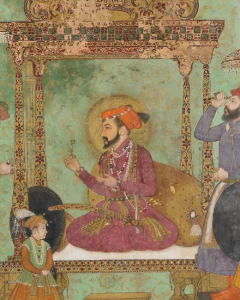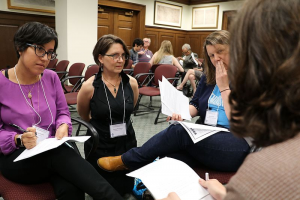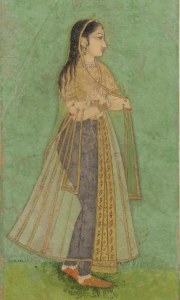
This post was written by Keala Richard, intern in the Freer|Sackler Library during the summer of 2016. Keala is currently working towards a Masters in Library and Information Science at the University of Hawaii, Manoa.
When I was a teenager, I spent countless afternoons gossiping and scheming with my best friend under the watchful eye of Mughal royalty. Her family’s collection of miniatures, stripped of their gilt borders and in many cases missing in-painting, still struck me as the most beautiful pieces in her parents’ massive collection of Indian art. Whenever I would sneak down the hall for midnight slumber party refrigerator raids, I would always stop and admire the princes and princesses painted in profile. When I first learned that I was awarded the Smithsonian Minority Awards Program Internship, I marveled at the serendipity of being selected for the Freer|Sackler Library’s Mughal Wikipedia Project. I would get to learn more about the gilded nobility on my best friend’s wall.
I do not have a background in art history. I haven’t taken a studio arts course since primary school. Instead, my current course of study is progressing towards a Masters in Library and Information Science at the University of Hawaii, Manoa. My skill set, while lacking in subject specialty for Asian art, makes me well prepared for the kind of reference inquiry process and bibliographic authority required for academic research. In other words, though I initially didn’t know the first thing about Mughal art, put me in “one of the finest repositories of Asian art resources in the United States,” and I can use my training as a librarian to find the information I need; and this is precisely what I did!

To describe the project, I must first describe the mission of Wikipedia. Every minute, there are as many as 90,000 page views on Wikipedia’s 5,000,000+ articles, and that’s just for the English language version. What many of those users don’t realize is that Wikipedia is an open-access, crowd sourced, information resource. Which means that absolutely anyone can contribute content to the articles, regardless of institutional affiliation or academic status.
Anyone who has written an undergraduate paper since 2001 will recall the familiar warning from Professors and TAs not to use Wikipedia as a source. This is because there is an inherent distrust of the information coming from crowd sourced platforms. Wikipedia is aware of this problem, and it is why the site’s administration and philosophy demands that all content added be adequately sourced from reliable publications and include complete citations. Through collaborative efforts with respected research and heritage institutions, Wikipedia and its parent organization, the Wikimedia Foundation encourage the involvement of users who not only have access to superior collections, but also the knowledge of how to properly evaluate and cite quality sources.
Think of Wikipedia as a living organism that is constantly growing and changing, and relies upon the users to feed it reliable, authoritative information to keep it from disintegrating into the chaos of conjecture and mindless internet trolling. This is where we come in.

My task was to use Freer|Sackler’s amazing research library to mine print resources for information related to Mughal art, architecture, and culture, but not currently represented on Wikipedia. To do this, I worked with two other interns under the supervision of SIL librarians. Initially working from an annotated bibliography and object list compiled by a Freer|Sackler volunteer, as well as generous hints from the expert curatorial staff, I created multiple search strategies. For the majority of my time, I targeted topics related to women’s issues is Mughal history (for that was the area I found the most neglected, buried beneath mountains of articles dedicated to military and civic accomplishments).
My research required that I not only construct efficient search queries, but also learn the available search functions of the Smithsonian Library’s online public access catalog (OPAC), SIRIS. To familiarize myself with information relative to the actual object holdings, I learned to navigate the public facing Collections Search Center and the museum’s internal content management system, TMS. However, the major hurdle in my continued quest for digital literacy in this project came with the actual Wikipedia contribution process itself.
For that, I turned to a, SIL cataloging staffer, and her amazing contacts at Wikimedia DC. The local arm of the Wikimedia Foundation performs front line outreach by actively organizing edit-a-thons, meet-ups, and even a conference every year. Lucky for me and the rest of my team, their conference was held during our tenure as interns this summer. As attendees, we learned about diversity issues in the Wikipedia community, received impromptu tutorials, were directed to learning resources, and made valuable contacts with DC Wikipedians, as well as representatives from the Wikimedia Foundation, and Wiki Education Foundation.

As I began to apply my search strategies, readings, and new found knowledge of the Wiki Markup coding language, my supervisor encouraged our team to share the project with the larger Smithsonian community. At the staff picnic, held in conjunction with Folk Life Festival on the National Mall, we had our chance. Collaborating with the Freer|Sackler design staff, and with a special guest appearance by our SIL Cataloger/Wikimedia DC representative, we presented at a poster session in the congress of scholars tent. Aside from the social benefits of sharing our project with the SI scholarly community, the poster session offered us the chance to really test our growing subject knowledge, by fielding questions about Mughal art, Wikipedia contributions, and the resources available at Smithsonian Libraries.
By the end of my internship, I felt confident in saying that I had completed the project successfully. By combing through nearly 700 books, manuscripts, articles, documents, photos and museum objects, the team has so far managed to add 186 individual edits, and 5 unique pages to the English Wikipedia, and we are still working! This summer, I’ve read more Indo-Islamic history than I can readily quantify. I’ve been given “back-stage” access to some of the most incredible museum collections in the world. I’ve collaborated with multiple departments within the Smithsonian, and even multiple organizations without. I’ve flexed my librarian muscles and found purpose for the training my graduate education continues to instill in me. I’ve enjoyed the privilege of being a part of this institution this summer, and most importantly, I’ve finally found context for those princes and princesses, painted in profile, that first intrigued my teenage self, 15 years ago.

Be First to Comment